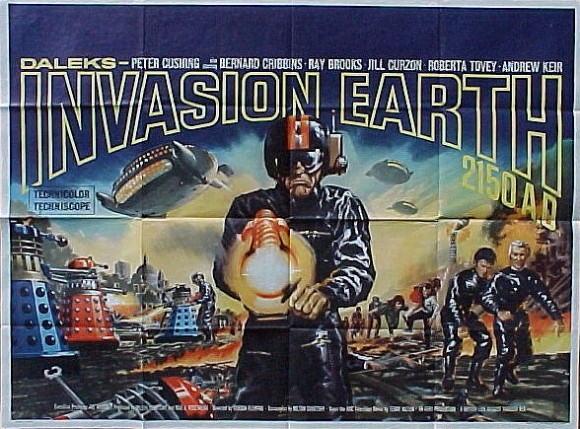
Having been a Doctor Who fan for many years, it seems something has now seeped into my DNA, a “fan gene” as it were, which means I have to go and see anything Who related when it’s nearby. Whether that’s a Doctor Who Roadshow, Doctor Who Live or screenings of TV episodes in Edinburgh and Glasgow, I’m usually there.
In the last few weeks that’s meant taking myself along to two screenings of the 1960s Doctor Who (sorry, Dr. Who?) films at Filmhouse, with the second screened this weekend to an appreciative audience.
William Hartnell was still the Doctor in blurry black and white on BBC One in 1965, but it was decided that a bigger name was required for the transition to cinema screens. Peter Cushing, already a household name from his work in the Hammer horrors, was drafted in as scientist Dr. Who, along with granddaughters Susan (Roberta Tovey) and Barbara Who (Jennie Linden).
No longer a crotchety alien, this version of the Doctor is an old buffer who has built Tardis (it’s not the Tardis anymore) in his back garden and has little grasp of the complexities of space and time travel. When Barbara’s new boyfriend, Ian (Roy Castle) pops round to visit, he’s soon whisked off to the planet Skaro so that Dr. Who can have a wander.
What must have appealed to fans at the time was a chance to see the Daleks in colour, their evil schemes played out upon a more visually exciting canvas than a BBC budget could ever hope for. This reworking of the very first Dalek TV adventure from 1963 retains many of its plot points and as such isn’t a particularly rewarding watch.
That’s not to say director Gordon Flemyng fails, it just might have been better if writer Milton Subotsky had made the rather dull Thals, whom Dr. Who spends quite a bit of time helping, more, well, cinematic.
Things righted themselves somewhat for 1966’s sequel, Daleks’ Invasion Earth: 2150 AD, based on the 1964 TV serial, The Dalek Invasion of Earth. Immediately there’s a feeling that everyone involved has more confidence in what they’re doing and that they simply want to give the audience a bit of a romp.
Sadly, Dr. Who hasn’t learned from his antics of the first film and he’s once again happy to send his time machine into the unknown, this time with Susan, niece Louise (Jill Curzon) and hapless policeman, Tom Cameron (Bernard Cribbins) aboard.
Tardis lands in, you’ve guessed it, 2150 AD, where the time team soon find themselves caught up in (you’ve guessed it) a Dalek invasion. In typical Doctor Who fashion, the Tardis crew are split up, captured and rescued multiple times, all the while trying to get themselves to the most important place on Earth, a mine in Bedford.
Daleks’ Invasion holds up well almost 50 years down the line. Bernard Cribbins’ Tom is an improvement on the first film’s Ian character; Andrew Keir makes a strong impression as Wyler, though a bit of back story might have been nice; some welcome moral ambiguity is introduced in the shape of Philip Madoc’s Brockley and Sheila Steafel’s spinster; and the whole thing looks like a few quid has been spent on it, with dozens of Daleks and a shiny new spaceship interior on show.
Gordon Flemyng adds some lovely flourishes to the picture, particularly in the scene where the Doctor is imprisoned and the camera circles him within a confined space. There’s also a longer sequence in the Dalek control room where Flemyng takes the camera behind various girders and handrails, lifting what would otherwise be a fairly bog standard scene into something more interesting.
It’s actually Cushing who comes out worst here. He does the job fine but is rarely the focus of the script, with so many characters vying for attention around him. I’m still not sure how I actually feel towards his Doctor, whether his casual attitude to time travel and the safety of his companions is something to be celebrated. OK, so he’s willing to do what he can to save them once they’re in trouble, but if he’d just settled down to a quiet retirement back in 1960s Earth they would have been fine.
Overall, it was a treat to see both films at the cinema in newly restored DCPs, meaning I probably won’t be buying the new Blu-ray sets that are out in the next few weeks. These aren’t films I can watch regularly, but perhaps in another 10 years there’ll be a chance to see them at the pictures again and I’ll be there.
Maybe I’ll feel differently towards Dr. Who and his ways by then.

